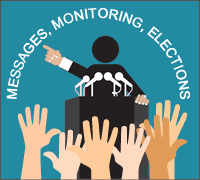|
||||||||||||||||
Election monitoring Final results of the media monitoring and accents of the elections’ monitoring
On June 5, 2014, at BTA Press Club a press conference was held, where the team of ISI presented the final results of the media monitoring and key issues of the elections’ monitoring, part of the "Monitoring the 2014 European Elections." The monitoring was carried out in three stages: electoral legislation, media monitoring and monitoring of the Election Day. Through the media monitoring, the team did monitoring and analysis of the media environment in Bulgaria in the context of the elections for European Parliament, in three main areas: the traditional quantitative monitoring and analysis of the coverage of the major parties, political leaders and candidates for seats in the European Parliament. And two new elements - monitoring local media and their analysis on European issues; and analysis of key messages of politicians and parties that reach Bulgarian citizens through the media in the country. 20 media (TV, print and websites) were included in the quantitative monitoring, and 16 222 information pieces were registered during the focus period from 25 March to 26 May. For two months, 25 leaders of political parties, leaders of lists and parties were covered. The trends, which had already been announced, were generally confirmed. Again, the political party GERB and its leader Boyko Borisov were most often in the focus of media. But the most positive coverage was for the coalition around Bulgaria without Censorship and its leader Nikolai Barekov. All the results of the quantitative monitoring will be announced in detail at the upcoming conference. To what extend are European topics covered by regional media and how they are presented to the audience - this was the second goal of media monitoring. That’s why, the team of ISI focused part of its efforts at monitoring the 12 regional media, covering the information flows in Burgas, Varna, Plovdiv, Sliven, Blagoevgrad, Sofia region, Kardzhali, Shumen and Veliko Tarnovo. 1351 pieces of information, concerning the elections, were recorded. Just 11% of them were related to the way of voting. Only 3% of the news mentioned the opportunities for European funding, and information regarding voting in the other countries of the European Union was almost absent. In search of answers to the questions "Why the crisis of confidence between citizens and politicians have deepened in recent years, in national and European plan?" and what are the reasons for the low voting activity, as a third element of the media monitoring, a parallel comparative analysis between the declared messages and key elements in the platforms /policy and program documents/ of leading parties was included. The team chose to monitor Coalition for Bulgaria, GERB, DPS, Reformist Bloc, ABC, Bulgaria without Censorship and Ataka, and to watch how their messages and key points have been communicated by the media to potential voters; how they have actually been covered in the month of the campaign. Our team registered a feeble link between these messages and the relevant European platforms, on one side. On the other, campaigns oscillated between Bulgarian-centrism, being totally apart from the European Union, and perfunctory endeavors to perform pan-European election campaigns on local ground. Monitoring on the Election Day, May 25th, was carried out in 25 regions of the country. The information, which was sent by the observers and summarized by our team, stands in the basis of an analytical report with recommendations for improving the electoral process. Among the main topics are: training and state of the electoral administration and the other participants in the electoral process, voters’ awareness, controlled voting, machine voting. The press conference was attended by Galina Assenova - Executive Director of the Institute, Stefan Georgiev - sociologist and coordinator of the media monitoring team, Gabriela Velitchkova - team member for media monitoring, Chavdar Naydenov – sociologist, and Tanya Balova - national coordinator of ISI observers on the Election Day. Presentation and summary of the final report with the presented monitoring results and analysis with emphasis on elections’ monitoring can be found in section "Publications" |
||||||||||||||||

